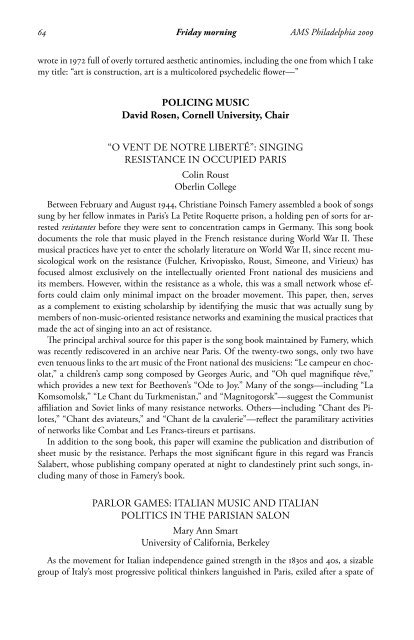AMS Philadelphia 2009 Abstracts - American Musicological Society
AMS Philadelphia 2009 Abstracts - American Musicological Society
AMS Philadelphia 2009 Abstracts - American Musicological Society
Create successful ePaper yourself
Turn your PDF publications into a flip-book with our unique Google optimized e-Paper software.
64 Friday morning <strong>AMS</strong> <strong>Philadelphia</strong> <strong>2009</strong><br />
wrote in 1972 full of overly tortured aesthetic antinomies, including the one from which I take<br />
my title: “art is construction, art is a multicolored psychedelic flower—”<br />
Policing Music<br />
David rosen, cornell university, chair<br />
“O VENT DE NOTRE LIBERTé”: SINGING<br />
RESISTANCE IN OCCUPIED PARIS<br />
Colin Roust<br />
Oberlin College<br />
Between February and August 1944, Christiane Poinsch Famery assembled a book of songs<br />
sung by her fellow inmates in Paris’s La Petite Roquette prison, a holding pen of sorts for arrested<br />
resistantes before they were sent to concentration camps in Germany. This song book<br />
documents the role that music played in the French resistance during World War II. These<br />
musical practices have yet to enter the scholarly literature on World War II, since recent musicological<br />
work on the resistance (Fulcher, Krivopissko, Roust, Simeone, and Virieux) has<br />
focused almost exclusively on the intellectually oriented Front national des musiciens and<br />
its members. However, within the resistance as a whole, this was a small network whose efforts<br />
could claim only minimal impact on the broader movement. This paper, then, serves<br />
as a complement to existing scholarship by identifying the music that was actually sung by<br />
members of non-music-oriented resistance networks and examining the musical practices that<br />
made the act of singing into an act of resistance.<br />
The principal archival source for this paper is the song book maintained by Famery, which<br />
was recently rediscovered in an archive near Paris. Of the twenty-two songs, only two have<br />
even tenuous links to the art music of the Front national des musiciens: “Le campeur en chocolat,”<br />
a children’s camp song composed by Georges Auric, and “Oh quel magnifique rêve,”<br />
which provides a new text for Beethoven’s “Ode to Joy.” Many of the songs—including “La<br />
Komsomolsk,” “Le Chant du Turkmenistan,” and “Magnitogorsk”—suggest the Communist<br />
affiliation and Soviet links of many resistance networks. Others—including “Chant des Pilotes,”<br />
“Chant des aviateurs,” and “Chant de la cavalerie”—reflect the paramilitary activities<br />
of networks like Combat and Les Francs-tireurs et partisans.<br />
In addition to the song book, this paper will examine the publication and distribution of<br />
sheet music by the resistance. Perhaps the most significant figure in this regard was Francis<br />
Salabert, whose publishing company operated at night to clandestinely print such songs, including<br />
many of those in Famery’s book.<br />
PARLOR GAMES: ITALIAN MUSIC AND ITALIAN<br />
POLITICS IN THE PARISIAN SALON<br />
Mary Ann Smart<br />
University of California, Berkeley<br />
As the movement for Italian independence gained strength in the 1830s and 40s, a sizable<br />
group of Italy’s most progressive political thinkers languished in Paris, exiled after a spate of










